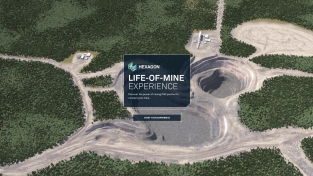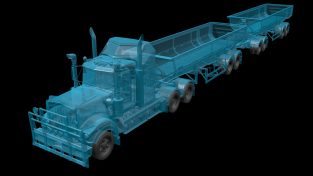Successfully integrating fleet management, machine guidance and operator assist solutions are considered keys to greater efficiency and productivity. We explain the progress being made in harmonising hardware and software to automate workflows, optimise haulage and blending, and deliver situational awareness.
NJ: Successfully integrating fleet management, machine guidance and operator assist solutions are considered keys to greater efficiency and productivity. What progress is being made in harmonising hardware and software to automate workflows, optimise haulage and blending and deliver situational awareness? In our continuing thought leader series Hexagon Mining division CTO, Rob Daw, is joined by portfolio manager, Larry Estep.
Thanks for tuning in. Hi, I’m Neville Judd from HxGN Radio. Imagine a consistent life of mine data store that connects to any system and enables data enrichment in a single interface available to everyone. Here to discuss the integration behind that vision are Hexagon Mining division CTO Rob Daw and portfolio manager, Larry Estep. Gentlemen thanks for joining us today.
LE: Thanks for having us, Nev.
RD: Thanks for having us, Nev.
NJ: You bet. So, Larry, we’ll start with you. You’re the PM for MineOperate, an operations portfolio with more than 125 active installations, 8,000 connected machines and 33,000 users. What’s the mission and vision for MineOperate?
LE: The mission and vision for the MineOperate portfolio has been in place for a number of years now and while it evolves the foundations of it haven’t changed. So, the mission of the portfolio is to deliver digital solutions that improve productivity and quality across operations and across the maintenance applications for open pit and underground mines. Pretty straightforward. Our vision is we aspire to be the technology partner for the operations and maintenance areas of the mine.
NJ: So, Rob, we kind of alluded to this in the intro. How realistic is the idea of one life-of-mine data store, a single source of truth so to speak for fleet management systems, machine guidance and equipment management that enables data enrichment and it’s available to everyone. How realistic is that?
RD: I think it is real today. So, it’s not just realistic, it is actually there today for us to touch and feel and for our clients to be able to get it out and to understand that. I think one thing there is that we shouldn’t just be limiting this to just our FMS or machine guidance or equipment-management solutions. If we do look at our life-of-mine data set we’re taking areas from exploration into drill and blast, into geological modelling into fleet management and beyond all the way through to the plant. It’s almost that whole mine to mill or exploration to export, if you want to have a look at that side of things and once we start to tie that information together, those data sets together, what we’ve seen is that there are some significant areas that we can improve these processes in and understand and be more proactive in our decision-making through the analysis and understanding of these data sets. So, I think we’re just tapping the surface at the moment as to what we can do but realistically some of, the big value I guess that we’ve had from Hexagon Mining is understanding the intricacies, the nuances of all of these different portfolios and information or siloed data sets. Once we’ve started to tie those together and get rid of some of the black-box mentality I guess, we’re really now starting to see some massive benefits and gains that our clients can really wrap their hands around and get some value from our solutions that we’ve put out there.
NJ: So, Larry describe for us some of those potential benefits that Rob just alluded to. What do they look like when you’re talking about this harmonised solution?
LE: If you think about the quality of your decisions, the quality of your decisions are heavily influenced by the quality of your data. The quality of your data is heavily influenced by the number of times you have to touch your data or manipulate your data or translate your data. So, if we can develop and implement a harmonised solution for a mining client, you’re going to see some pretty obvious things. The elimination of duplicate entries of data, elimination of the chance of human error. You’re going to substantially reduce the time that people spend on identifying which data is correct and which is the source of truth. You’re going to improve that data intelligence that our mining clients need to make those critical decisions. So, having a harmonised solution, from pit to port across the mining value chain has significant value for the mining customers and I’m excited about being a part of a solution that we can deliver that for our mining customers.
RD: I think also Larry, not just on that, I think some of the value that we get with situational awareness. Being able to pull these different data sets together. Worst-case scenario, we use it for an incident investigation let’s say, but having the information from Asset Health, which said yes, we had high oil pressure, we had information from our fleet management saying, we’re overloaded, we have information from our MineProtect portfolio saying we’re speeding in a particular intersection, or we had two vehicles that came and had a near-miss. Once we tie that information together and actually start to get what was that full situation and scope of that information, we are now actually able to make better decisions on those. So, I think that’s the real, once we get those harmonised solutions and we see that data really integrating together between different product lines to provide that situational awareness, that is then really starting to provide an unparallelled amount of information that our clients can access.
NJ: Larry, how does underground compare to open pit when it comes to achieving a solution with these kinds of benefits?
LE: The needs are exactly the same. Obviously, there are significant differences between an underground and an open or surface mining application, but at the end of the day, they all have the same goals, which is to move the most amount of material at the lowest cost in the safest manner. So, having, whether you’re working in a confined environment like underground or in an open pit surface mining application, having contextual information about your operations and being able to integrate that data and solutions with other functions at the mine, whether that be safety or machine health, it’s the exact same thing. Obviously how we implement those things is going to vary but at the end of the day, the goals are the same.
RD: I think the goals are the same, Larry, but one of the things I find interesting is that the goals are the same but the drivers are different. So, you know, open pit we’re very much heavy on how do we optimise our fleet, our equipment to make sure it’s being used most effectively as possible? But then when we move underground, we actually change our focus from equipment more so to location-based and how are we actually optimising our location because we have a much more structured workflow through those locations. So, I agree they’re definitely the same but it’s always interesting to understand that the drivers are different and I think that’s one of the key things as to why we’ve had two different focuses in the Hexagon portfolio of open pit and underground solutions because you need to make sure that that solution is designed and delivered and tailored based on those drivers in the organisation and in the operation.
NJ: When you consider risk versus investment for customers, how important is it that the solutions are scalable when it comes to data and machine integration, Larry?
LE: Hexagon recognises that mining clients’ needs evolve over time. We recognise that investment dollars are limited and that organisational change management is challenging. These things drive the need to invest wisely and scalable integrated solutions that allow the mines to take on new functionalities and capabilities at the speed that they desire. I think it’s important though that as they go through their journey that they have the ability, like I indicated, to scale, to be able to add things as their needs change and that that’s a seamless transition or a seamless integration.
RD: Conditions change too, right? Over time, the mine’s requirements change. So, if we can help them out if we can add additional features, functionality. If they can put their trust in us as a valued partner, there’s definitely opportunity for us to be able to continue to scale with that operation and that’s not just about numbers or fleets or anything else but that’s actually about value that we add back. I think that’s one of the key factors there.
NJ: Gentlemen, thanks so much for joining us today.
RD: Thanks, Nev.
NJ: A big thank you to our guests, Rob and Larry. For more information about today’s topic, visit hexagonmining.com. To listen to additional episodes or learn more, visit hxgnspotlight.com. Thanks for tuning in.
















